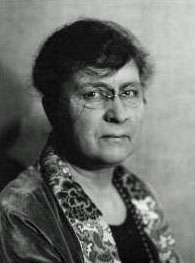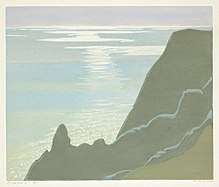Mary E. Wrinch
Mary Evelyn Wrinch (1877–1969), was a Canadian artist who created miniature paintings, colour block prints and oil paintings, sometimes inspired by the great Northern Ontario landscape.[1][2] She pioneered the 'Canadian style', painting landscapes with bold colours of the Algoma, Muskoka and Lake Superior regions, in situ.[3] In her miniature paintings on ivory, she depicted her sisters with freshness and vitality. Her colour block prints are virtuoso examples of the medium.[4]
Mary Evelyn Wrinch | |
|---|---|
 | |
| Born | 1877 Kirby-le-Soken, United Kingdom |
| Died | 1969 (aged 90–91) Toronto, Canada |
| Nationality | Canadian |
| Education | Central Ontario School of Art, Grosvenor School of Modern Art |
| Known for | Painting |
| Spouse(s) | George Agnew Reid ( m. 1922) |
Early life
Wrinch was born in 1877 in Kirby-le-Soken, Essex in the United Kingdom to her parents, Leonard and Elizabeth Cooper Wrinch.[5] Upon her father's passing, she immigrated with her mother to Bronte, Ontario, and by the age of 8, relocated to Toronto, Ontario.[5] Within Toronto, she attended the Bishop Strachan School, a private school in the Forest Hill area, in 1889.[6] In the 1890s, Wrinch studied under George Agnew Reid (whom she later married in 1922) along with artists Laura Muntz Lyall and Robert Holmes[7] at the Central Ontario School of Art.[1] Wrinch attended the Central Ontario School of Art from 1889–1893, (now known as Ontario College of Art and Design) where she studied both printmaking and painting. She went through numerous degrees, beginning her graduate studies at Grosvenor School of Modern Art in London until 1899 under the direction of Walter Donne.[8][9] Wrinch later returned to Toronto where she studied at the Ontario College of Art & Design under Laura Muntz Lyall, Robert Holmes and George Agnew Reid.[1] She later took part in two private studies, one in London, England under Alyn Williams,[10] and another in New York under Alice Beckington, before joining the Art Students’ League in New York.[9]
Career
Wrinch was the Art Director at Bishop Strachan School (BSS) from 1901–1936. While holding this position, she designed the school's chapel interior, including a large stained-glass window.[11]
Throughout her career in education and art, Wrinch worked towards gaining access to several artistic memberships. Wrinch actively worked with the Ontario Society of Artists, a professional artist association advocating for visual arts through exhibitions and special projects. Wrinch held membership at Heliconian Club and Women's Art Association of Canada, which are two non-profit associations that connect and promote women's participation in the arts.[12] Wrinch also held membership within the Canadian Society of Painters in Watercolour, Royal Canadian Academy of Arts, American Society of Miniature Painters, Canadian Handicrafts Guild and Canadian Society of Graphic Art.[12]
Wrinch's first commercial exhibition was at The Art Metropole[13] (241 Yonge Street) in 1966.[12] It was curated by dealer Jerrold Morris and included 50 of Wrinch's works alongside 50 of Mary Heister Reid’s works.[12] Wrinch’s first public exhibition was in 1969 at the Art Gallery of Ontario and was curated by Joan Murray.[14]
Little scholarship on Mary Wrinch's art exists to date. Muriel Miller[15] originally wrote on the artist's life and career in 1940.[14] Curator Joan Murray wrote, "Mary Wrinch: Canadian Artist," in the journal, Canadian Antiques Collector, in 1969. This essay remains as the most significant and comprehensive writing on Wrinch's art.[14]
Wrinch frequently sketched with her husband, George Reid, in Algoma, Temagami, Bruce Peninsula and Ottawa Valley.[5] She ended her artistic career in 1944.[3]
Artwork

Wrinch worked in multiple artistic mediums including oil paint, watercolour, drawing and print.[16] She is best known for her linoleum block style prints.[14] Wrinch's earliest use of black and white linoleum block prints was in 1928.[3] By 1930, she introduced colour to her prints by using linocut.[3] Landscapes of Northern Ontario and florals are her most common print subjects. Her two most well-known works are Breaking Clouds[17] (1931–1932) and Scarboro[18] (1935–1938).[3] Both works are colour linocut on wove paper and are found in the Canadian Prints and Drawings section of the National Gallery of Canada.[19]
Personal life
In 1922, Wrinch married George Agnew Reid, a Toronto based mural painter and architect to whom she also closely worked under at the Central Ontario School of Art.[1] Wrinch's marriage to Reid occurred soon after the death of Reid's first wife, Mary Hiester Reid (1854–1921).[1] Wrinch and Reid lived together in the Wychwood Park area, known as the arts and crafts community as it holds Toronto favourites such as the Artscape Wychwood Barns. After 25 years of marriage, George Agnew Reid died in 1947.[1] Wrinch died in Toronto in 1969 at age 90. Her works can still be found within the Art Gallery of Ontario: Edward P. Taylor Research Library and Archives, the London Public Library in Ontario, the Montreal Museum of Fine Arts, the National Gallery of Canada’s Library and Archives, the University of British Columbia’s Fine Arts Library, the Vancouver Art Gallery Library, the Hamilton Public Library Local History and Archives Department, the Canadian Women Artists History Initiative Documentation Centre[20] and Library and Archives Canada.[5]
See also
References
- Harper, J. Russell. Early Painters and Engravers in Canada, Toronto: University of Toronto, 1970.
- Sparkling Water: Mary Wrinch and her Contemporaries. Toronto: Art Gallery of Ontario. 1969.
- Heller, Jules and Nancy Heller. North American Women Artists of the Twentieth Century: A Bibliographic Dictionary. New York: Garland Publishing, 1995.
- Sparkling Water: Mary Wrinch and her Contemporaries. Toronto: Art Gallery of Ontario. 1969.
- Mastin, Catharine, Mary E. Wrinch and the AGW Collection, exhibition catalogue, Art Gallery of Windsor, Windsor, 2012.
- Butlin, Susan. The Practice of her Profession: Florence Carlyle, Canadian Painter in the Age of Impressionism. Kingston: McGill Queen's University Press, 2009.
- Robert Holmes
- Walter Donne
- Barry, Virginia G. Taming the Frontier: Art and Women in the Canadian West 1880–1920. Winnipeg: The Winnipeg Art Gallery, 2005
- Alyn Williams
- "Girls Private University Prep & Boarding School in Toronto | BSS". BSS. Retrieved 2018-03-26.
- Kritzwiser, Kay. "Mary Wrinch Remains a Rebel at 90." The Globe and Mail, October 15, 1966. Accessed March 8, 2018.
- The Art Metropole
- Miller, Muriel. Famous Canadian Artists. Salt Lake City: Woodland Publishing, 1983.
- Muriel Miller
- Ainslie, Patricia. Images of the Land: Canadian Block Prints, 1919–1945. Calgary: Glenbow Museum, 1984.
- Breaking Clouds
- Scarboro
- "Mary E. Wrinch". www.gallery.ca. Retrieved 2018-03-26.
- Canadian Women Artists History Initiative Documentation Centre
Further reading
- Dickman, Chris (1980). The Prints of Mary Wrinch. Durham Art Gallery. OCLC 636063576.
External links
- images of Mary E. Wrinch's paintings at the National Gallery of Canada